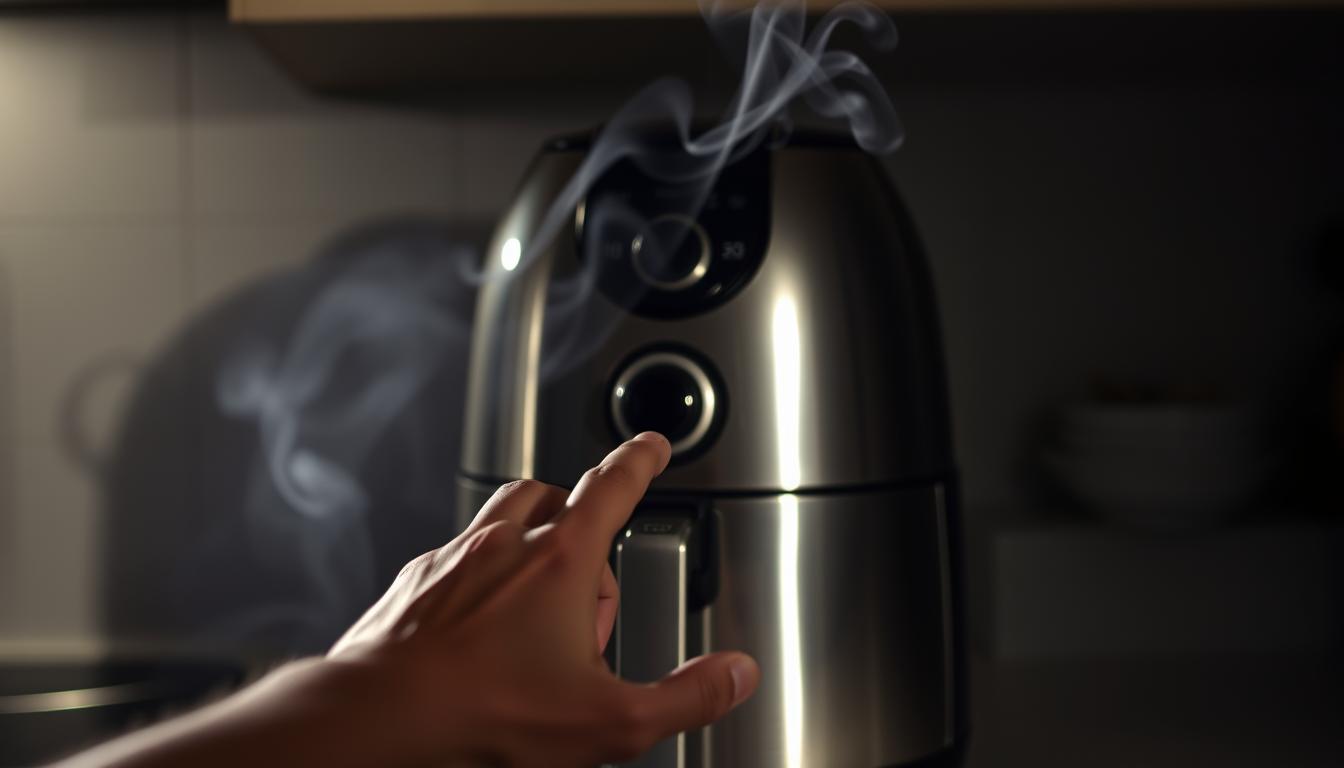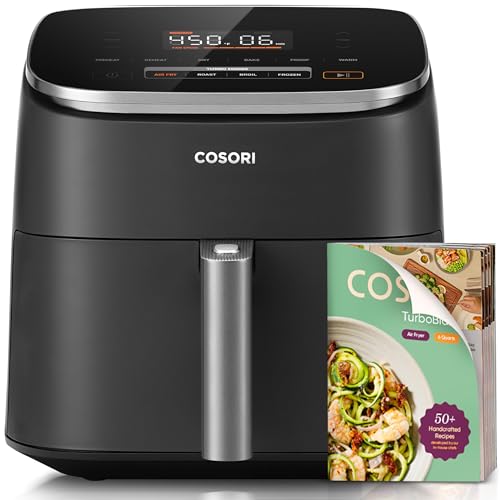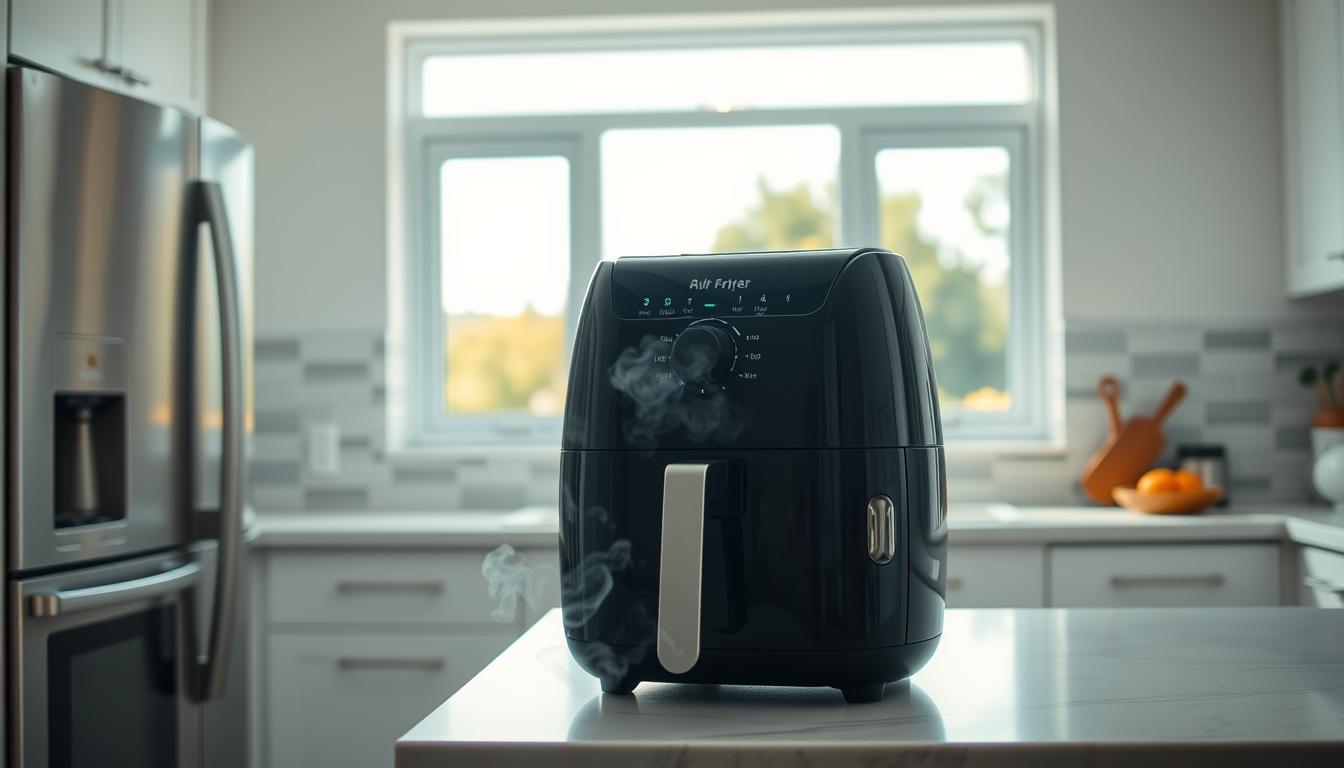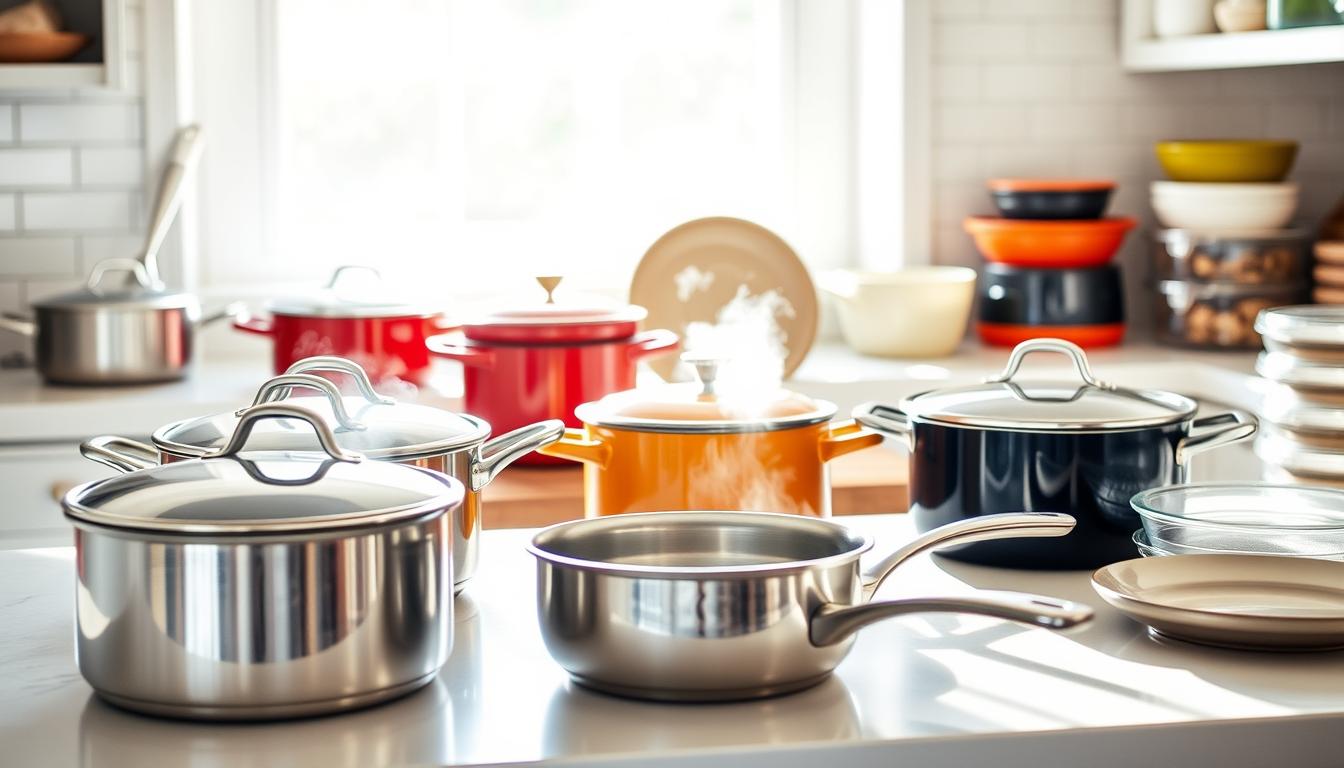Are air fryers harmful? Discover the truth about air fryer safety, potential risks, and tips to cook healthier meals without detrimental effects.
Table of Contents
As we continue to seek healthier alternatives for cooking, air fryers have gained popularity for their promise of crispy food with less oil. However, concerns about their safety have sparked debates.
Questions surrounding air fryer toxicity have left many wondering if these appliances are truly safe for home use. The concern is valid, given the potential risks associated with specific cooking methods and materials used in some air fryers.
At a Glance- Key Takeaways
- Understanding the potential toxicity risks associated with air fryers.
- Examining the safety features of modern air fryers.
- Best Practices for Safe Air Fryer Usage.
- The importance of choosing air fryers from reputable manufacturers.
- Regulatory guidelines for air fryer safety.
Understanding Air Fryer Technology
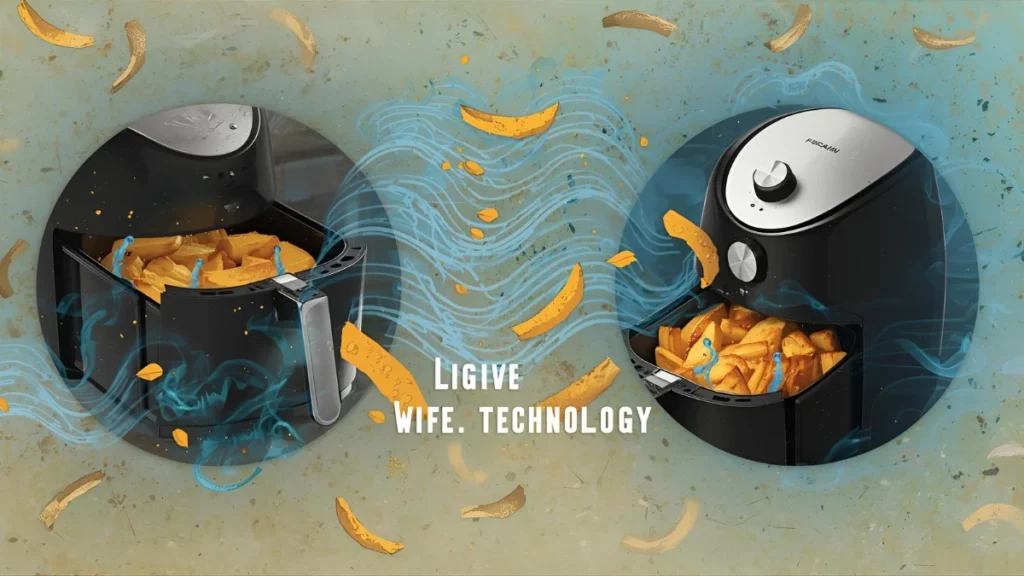
How Air Fryers Work
The technology behind air fryers is more complex than you might think, involving a combination of heating elements and advanced air circulation systems. This synergy enables air fryers to cook food evenly, achieving that desirable crispy exterior and tender interior with minimal oil.
Air fryers operate by using a heating element to warm the air inside the cooking chamber. A fan then circulates this hot air around the food at high speed, resulting in even cooking and browning. This process is known as convection cooking, and it’s what allows air fryers to produce fried-like results without submerging food in oil.
Components and Materials Used
The construction of air fryers involves various components and materials, including non-stick coatings on the cooking baskets, plastic or metal exterior parts, and metal or ceramic elements within the cooking chamber. The choice of these materials can impact the safety and performance of the air fryer. For instance, non-stick coatings can be made from PTFE (Teflon) or ceramic, each having its own safety profile and maintenance requirements.
Are Air Fryers Harmful? Examining the Evidence
As air fryers continue to gain popularity, it’s essential to investigate the evidence surrounding their safety and potential toxicity. The increasing use of air fryers has raised concerns about their possible health impact, making it crucial to examine the scientific research and regulatory standards governing these devices.
Scientific Research on Air Fryer Safety
Several studies have investigated the safety of air fryers, focusing on the chemicals released during cooking and the materials used in their construction. Research has shown that when heated, specific components of air fryers can release potentially harmful substances. For instance, a study published in a reputable scientific journal found that certain non-stick coatings can degrade at high temperatures, releasing toxic fumes.
Regulatory Standards and Compliance
Air fryer manufacturers must comply with various regulatory standards to ensure their products are safe for consumer use. In the United States, the FDA regulates the materials used in cookware, including air fryers. Manufacturers are required to adhere to guidelines that prevent the use of harmful substances in their products.
| Regulatory Body | Standards | Compliance Requirements |
|---|---|---|
| FDA | Guidelines for cookware materials | Pre-market approval for certain materials |
| UL (Underwriters Laboratories) | Safety standards for electrical appliances | Certification required for market entry |
By understanding the scientific research and regulatory standards surrounding air fryers, consumers can make informed decisions about their use of these appliances.
Common Materials in Air Fryers and Their Safety Profiles
Understanding the materials used in air fryers is crucial for assessing their safety. Air fryers are made from a variety of materials, each with its own safety profile.
Non-Stick Coatings: PTFE and PFOA Concerns
Many air fryers feature non-stick coatings for easy food release and cleaning. However, these coatings often contain chemicals like PTFE (polytetrafluoroethylene) and PFOA (perfluorooctanoic acid), which have raised health concerns. PTFE can release toxic fumes when heated to high temperatures, and PFOA has been linked to various health issues. Consumers should exercise caution and consider alternative options.
Plastic Components and Heat Exposure
Some air fryers include plastic components that can be exposed to high temperatures during use. Heat can cause plastics to leach chemicals into food, potentially leading to health risks. It’s essential to check if the plastic parts are heat-resistant and BPA-free.
Metal Elements and Potential Leaching
Air fryers also contain metal elements that can be a source of concern. Certain metals can leach into food, especially when cooking acidic or salty dishes. Stainless steel components are generally considered safer than other metals, as they are less likely to leach harmful substances.
By being aware of these materials and their potential risks, consumers can make informed decisions about the use and maintenance of air fryers.
Potential Health Risks Associated with Air Fryers
While air fryers are praised for their convenience, their health implications are being closely examined. The use of air fryers has become widespread due to their promise of frying foods with less oil, but it’s crucial to understand the potential health risks associated with their use.
Chemical Emissions During Cooking
One of the primary concerns is the emission of chemicals during the cooking process. When heated, some components of air fryers, such as non-stick coatings, can release fumes that may be harmful if inhaled. It’s essential to ensure good ventilation when using an air fryer to minimize exposure to these potential emissions.
Acrylamide Formation in Air-Fried Foods
Another health concern is the formation of acrylamide in foods cooked at high temperatures. Acrylamide is a known carcinogen that forms when starchy foods are fried or cooked at high heat. Choosing the right foods and cooking temperatures can help minimize the formation of acrylamide. For instance, cooking at lower temperatures and not overcooking can reduce the risk.
Comparing Air Fryer Risks to Other Cooking Methods
To put these risks into perspective, it’s helpful to compare the health risks associated with air frying to those of other cooking methods. The table below summarizes some key differences:
| Cooking Method | Chemical Emissions | Acrylamide Formation Risk |
|---|---|---|
| Air Frying | Potential emissions from non-stick coatings | High risk if not used correctly |
| Deep Frying | High emissions from oil degradation | High risk |
| Baking | Low risk | Lower risk compared to frying methods |
By understanding these risks and taking steps to mitigate them, such as proper maintenance and usage of air fryers, individuals can make informed choices about their cooking methods.
Hidden Health Concerns You Should Know About
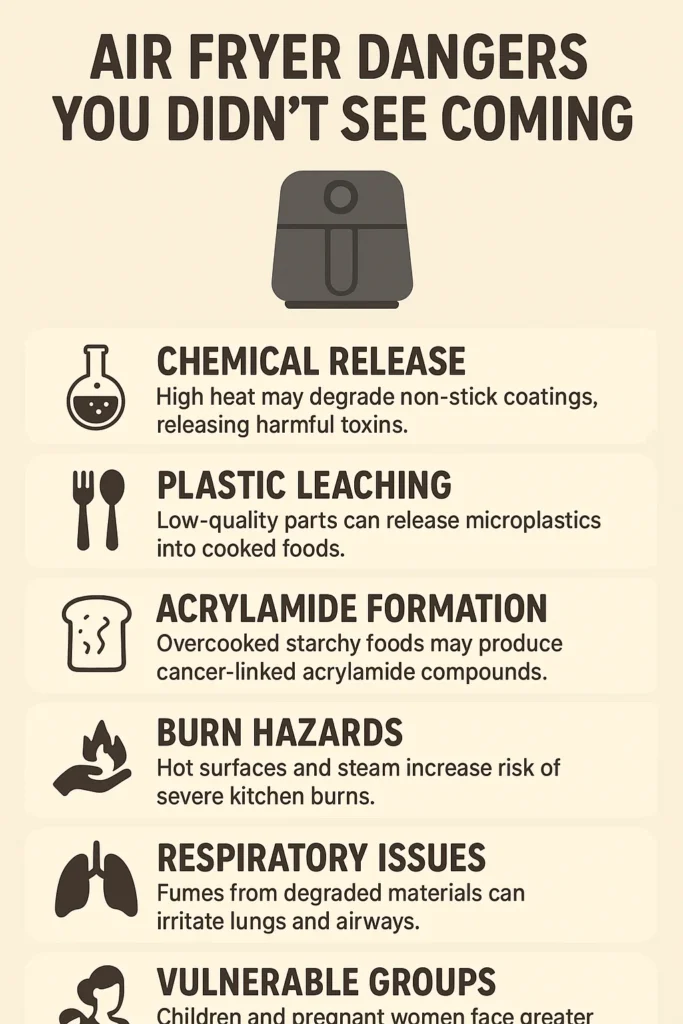
While air fryers offer a healthier alternative to deep-frying, there are hidden health concerns associated with their use that need to be addressed. As with any kitchen appliance, understanding the potential risks is crucial for safe usage.
Long-term Exposure Considerations
Prolonged use of air fryers may lead to specific health issues. For instance, repeated exposure to high temperatures can cause the degradation of non-stick coatings, potentially releasing harmful chemicals into the environment. It’s essential to consider the materials used in your air fryer and how they might affect your health over time.
- Regularly inspect your air fryer for signs of wear and tear.
- Follow the manufacturer’s guidelines for maintenance and replacement parts.
- Be mindful of the cooking temperatures and times to minimize potential chemical releases.
Vulnerable Populations: Children and Pregnant Women
Certain groups, such as children and pregnant women, may be more susceptible to the potential health risks associated with the use of air fryers. These populations must take extra precautions when using or being around air fryers.
Precautions for Vulnerable Populations:
- Keep air fryers out of children’s reach to avoid accidents.
- Pregnant women should exercise caution when exposed to potential chemical emissions during cooking.
By being aware of these hidden health concerns and taking appropriate measures, you can enjoy the benefits of air frying while minimizing potential risks.
Real Risk or Overblown Concern?
The debate surrounding air fryer safety has sparked intense interest, with many questioning whether the concerns are legitimate or exaggerated. As the popularity of air fryers continues to grow, it’s essential to examine the risks associated with their use.
Putting Air Fryer Risks in Perspective
To understand the potential risks, it’s crucial to look at the materials used in air fryer construction and how they interact with food during cooking. Non-stick coatings and plastic components are often cited as potential sources of toxicity. However, most modern air fryers are designed with safety in mind, adhering to regulatory standards that minimize exposure to harmful chemicals.
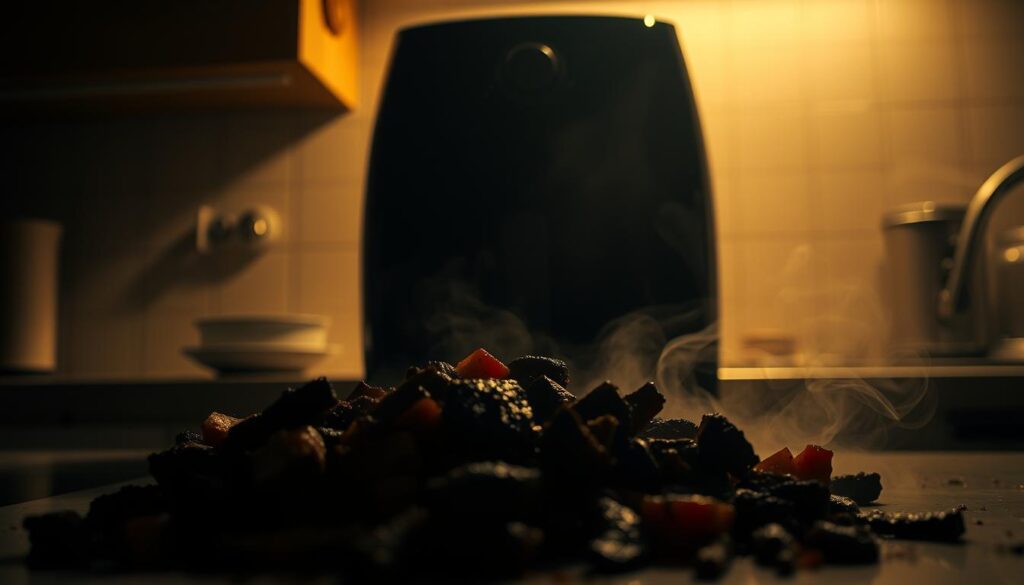
Media Coverage vs. Scientific Consensus
Media reports frequently highlight potential health risks, including the formation of acrylamide and chemical emissions that occur during cooking. While these concerns are valid, it’s essential to consider the scientific consensus. Research indicates that when used properly, air fryers are a relatively safe cooking option. The key is to follow manufacturer guidelines, maintain the appliance correctly, and be mindful of cooking temperatures and times.
By putting air fryer risks into perspective and understanding the scientific consensus, consumers can make informed decisions about their use of these appliances.
How to Check if Your Air Fryer Is Toxic
To ensure your air fryer isn’t harming your health, it’s crucial to know how to check for toxicity. Checking if your air fryer is toxic involves a few simple steps that can help you identify potential safety risks.
Warning Signs of Unsafe Materials
One of the first steps in checking your air fryer’s toxicity is to look for warning signs of unsafe materials. Non-stick coatings that are chipped or flaking can be a red flag, as they may contain harmful chemicals like PTFE or PFOA. Additionally, if your air fryer has a strong chemical smell when in use, it could indicate the presence of toxic materials.
Testing Methods for Home Use
While there are no foolproof DIY tests for air fryer toxicity, you can perform some simple checks. Inspect your air fryer for any damage to the non-stick coating or other components. You can also check for certifications, such as those from Underwriters Laboratories (UL) or FDA compliance, which indicate that the product meets specific safety standards.
Understanding Product Labels and Certifications
Product labels and certifications can provide valuable information about the safety of your air fryer. Look for labels that indicate compliance with regulatory standards, such as those stating the product is PTFE-free or PFOA-free. Understanding these labels can help you make informed decisions about the safety and potential toxicity of your air fryer.
Advances in Safer Air Frying Technology
Advancements in air fryer technology have focused on enhancing safety features and reducing health risks. Manufacturers are now prioritizing the development of air fryers that not only provide healthier cooking options but also minimize potential toxicity.
Ceramic-Coated Air Fryers
Ceramic-coated air fryers have emerged as a safer alternative to traditional non-stick models. The ceramic coating provides a non-toxic and durable surface for cooking, reducing the risk of chemical emissions during the cooking process.
Stainless Steel Options
Stainless steel air fryers are another innovation in safer air frying technology. These models are resistant to corrosion and do not leach chemicals into food, making them a healthy choice for consumers.
The Game-Changer in Air Fryer Manufacturing
A significant development in air fryer manufacturing is the integration of advanced materials and designs that enhance safety. For instance, some models now feature improved ventilation systems and temperature control mechanisms that reduce the formation of harmful compounds during cooking.
| Feature | Ceramic-Coated Air Fryers | Stainless Steel Air Fryers |
|---|---|---|
| Non-Toxic Material | Yes | Yes |
| Durability | High | Very High |
| Chemical Emissions | Low | Minimal |
These advancements in air fryer technology represent a significant step towards safer cooking practices. By choosing air fryers with safer materials and designs, consumers can enjoy the benefits of air frying while minimizing potential health risks.
Top Non-Toxic Air Fryer Options on the Market
If you’re in the market for a healthier air frying option, several brands offer non-toxic air fryers that prioritize user safety and health. These models are designed to minimize potential health risks associated with traditional air fryers.
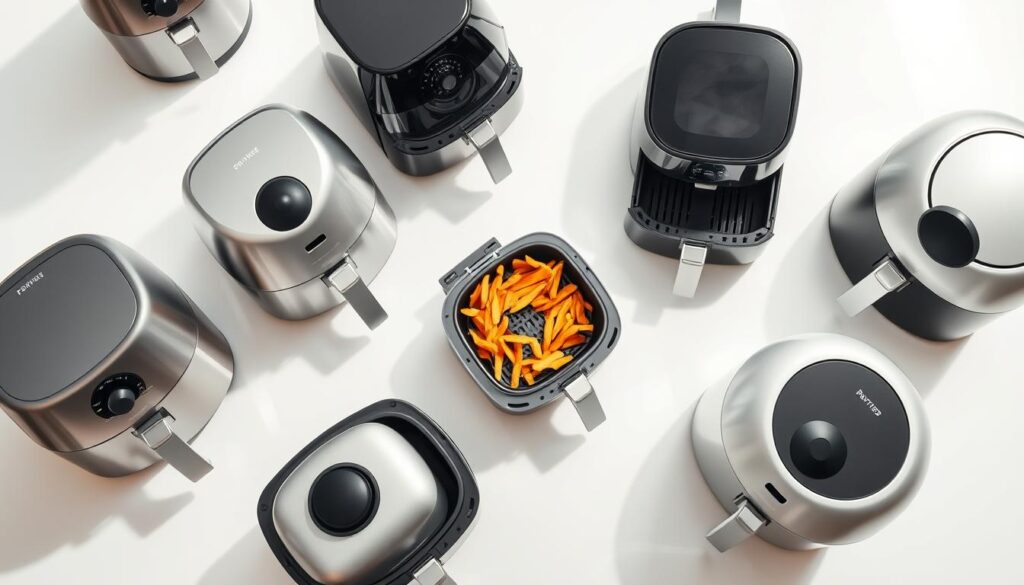
Ceramic-Coated Models
Ceramic-coated air fryers are a popular choice for those seeking non-toxic cooking options. Brands like Cuisinart and Black+Decker offer models with ceramic-coated baskets that are free from PTFE and PFOA. These coatings provide a safer alternative for cooking at high temperatures.
Cosori 9-in-1 TurboBlaze Air Fryer 6 Qt
Specifications
Product Dimensions:14.4″D x 11.8″W x 11.9″H
Technology: TurboBlaze Technology
Capacity: 6 qt
Temperature Range: 90°-450°F/ 30°-230°C
Special Features: Temperature Control, Automatic Shut-Off, 𝟵 Versatile Cooking Functions & 𝟱-𝗟𝗲𝘃𝗲𝗹 Fan Speed & 𝟰 Turbo Modes
Materials: Ceramic-coated non-stick
Cleaning: Dishwasher-safe
Recommended Uses: Defrost, Roast, 𝗧𝘂𝗿𝗯𝗼 𝗠𝗼𝗱𝗲𝘀 (Air Fry, Roast, Broil, Frozen) & 𝗣𝗿𝗼𝗼𝗳 Bread & 𝗗𝗲𝗵𝘆𝗱𝗿𝗮𝘁𝗲 Jerky and Fruits & 𝗕𝗮𝗸𝗲 Soft Cookies & 𝗥𝗲𝗵𝗲𝗮𝘁 Left Overs & 𝗞𝗲𝗲𝗽 𝗪𝗮𝗿𝗺 & 𝗖𝘂𝘀𝘁𝗼𝗺𝗶𝘇𝗮𝗯𝗹𝗲 𝗣𝗿𝗲𝗵𝗲𝗮𝘁
Stainless Steel Air Fryers
Stainless steel air fryers are another safe option for consumers. They are durable, resistant to scratches, and easy to clean. Brands such as Breville and Ninja offer stainless steel models that are not only non-toxic but also provide excellent cooking performance.
Chefman Air Fryer – 6 QT Compact Airfryer
Specifications
Product Dimensions:14.88″D x 11.1″W x 11″H
Technology: Hi-Fry technology
Capacity: 6 qt
Temperature Range: 90°-450°F/ 30°-230°C
Special Features: 4 Cooking Presets, 450°F Hi-Fry Technology, Automatic Shut-Off, Digital Touch Controls
Materials: Stainless Steel
Cleaning: Dishwasher-safe Basket and Rack
Recommended Uses: Air Fry, Bake, Reheat, Roast
Glass Bowl Air Fryers
For those seeking an alternative to traditional air fryer designs, glass bowl air fryers offer an innovative option. These models use a glass bowl instead of a basket, offering a non-toxic and easy-to-clean cooking experience. Brands like Philips have introduced glass bowl air fryers that combine safety with advanced cooking technology.
Ninja Crispi 4-in-1 Portable Glass Air Fryer
Specifications
Product Dimensions:13.38″D x 11.96″W x 13.58″H
Technology: Air Fry Technology
Capacity: 4 qt
Temperature Range: 22°-450°F
Special Features: Automatic Shut-Off, Programmable, Temperature Control, Timer
Materials: Metal/Glass
Cleaning: Containers, crisper plates, adapter, and lids are dishwasher safe.
Recommended Uses: Bake, Reheat, Roast
When choosing a non-toxic air fryer, it’s essential to consider factors such as material safety, brand reputation, and customer reviews. By opting for one of these safer models, consumers can enjoy the benefits of air frying while minimizing potential health risks.
Smart Tips for Safer Air Frying
To get the most out of your air fryer while ensuring safety, it’s crucial to follow some key guidelines. Air fryers offer a healthier alternative to traditional deep-frying. Still, like any kitchen appliance, they require careful use and maintenance.
Proper Usage and Maintenance
Regular cleaning is essential to prevent the buildup of food residue, which can become a breeding ground for bacteria. Ensure that you wash the basket and pan after every use with soap and warm water. Additionally, check your air fryer’s manual for specific maintenance instructions, such as replacing parts or cleaning the heating element.
Temperature Control for Reduced Toxicity
Temperature control is vital when using an air fryer. Cooking at excessively high temperatures can lead to the formation of harmful compounds. Always refer to the recommended temperature settings for different types of food. For instance, cooking delicate foods like fish at lower temperatures can help prevent the release of potentially toxic substances.
Food Choices That Minimize Health Risks
The type of food you cook in your air fryer can also impact safety. Avoid cooking foods high in fat or those that are prone to charring, as these can increase the risk of forming acrylamide, a known carcinogen. Opting for a variety of vegetables, lean proteins, and whole foods can not only make your meals healthier but also safer.
When to Replace Your Air Fryer
Air fryers, like any other appliance, have a limited lifespan and require periodic replacement. Understanding when to replace yours can help maintain kitchen safety and ensure your meals remain healthy.
Signs of Deterioration and Increased Risk
Several signs indicate that your air fryer is deteriorating and may need replacement. These include:
- Non-stick coating damage: If the non-stick coating is chipping or flaking, it indicates that the air fryer’s safety is compromised.
- Unusual noises or smells: Grinding noises or burning smells during operation can indicate worn-out parts.
- Visible wear and tear, such as rust, corrosion, or broken components, are clear indicators that it’s time for a new air fryer.
| Signs of Deterioration | Potential Risk |
|---|---|
| Non-stick coating damage | Chemical contamination of food |
| Unusual noises or smells | Mechanical failure or fire hazard |
| Visible wear and tear | Increased risk of electrical shock or fire |
Optimal Replacement Timeline
Typically, an air fryer can last between 3 and 5 years with proper care. However, this timeline can vary based on usage and maintenance. Regularly inspecting your air fryer and replacing it when necessary can help prevent potential health risks.
Conclusion: Balancing Convenience and Safety
As we’ve explored the world of air fryers, it’s clear that these appliances offer a convenient way to enjoy fried foods with less oil. However, the debate over convenience versus safety surrounding the use of air fryers is ongoing. To maximize air fryer safety, it’s crucial to be aware of potential risks and take practical steps to mitigate them.
By understanding air fryer technology, being aware of the materials used, and following proper usage guidelines, consumers can enjoy the benefits of air frying while maintaining a safe cooking environment. Choosing non-toxic air fryer options, such as those made from ceramic-coated or stainless steel, can also contribute to a safer cooking experience.
Ultimately, striking a balance between convenience and safety is key to enjoying the benefits of air fryers. By staying informed and adopting safe cooking practices, individuals can make the most of this popular kitchen appliance.
FAQ
Are air fryers Harmful?
Air fryers can potentially release toxic chemicals, such as acrylamide, when cooking certain foods at high temperatures. However, the risk can be minimized by following proper usage guidelines and choosing air fryers made with safer materials.
What are the potential health risks associated with air fryer use?
Potential health risks include chemical emissions during cooking, acrylamide formation in air-fried foods, and the leaching of chemicals from non-stick coatings or other materials. Proper use, maintenance, and the right choice of air fryer can help mitigate these risks.
How can I check if my air fryer is toxic?
Look for warning signs such as peeling non-stick coatings, damaged or rusted parts, and follow simple testing methods. Understanding product labels and certifications, such as PFOA-free or BPA-free, can also help determine the safety of your air fryer.
What are some safer air fryer options available?
Safer options include ceramic-coated air fryers, stainless steel models, and glass bowl air fryers. These alternatives reduce the risk of toxic chemical emissions and are generally considered safer for cooking.
How can I minimize health risks when using an air fryer?
To minimize risks, follow proper usage and maintenance guidelines, control temperature settings, and make informed food choices. Regularly cleaning your air fryer and avoiding overheating can also help reduce potential health hazards.
When should I replace my air fryer?
Replace your air fryer when you notice signs of deterioration, such as worn-out non-stick coatings, damaged parts, or if it no longer functions properly. The optimal replacement timeline varies, but generally, air fryers should be replaced every 2-5 years, depending on usage.
Are there any specific safety concerns for vulnerable populations, such as children and pregnant women?
Vulnerable populations should be cautious when using air fryers due to potential chemical emissions and other health risks. Pregnant women and children may need to take extra precautions, such as avoiding high-temperature cooking and ensuring good ventilation.
How do air fryer risks compare to other cooking methods?
Air fryer risks are generally comparable to or lower than those associated with deep-frying. However, air frying can still pose health risks if not done properly. Comparing air frying to other cooking methods like grilling or baking can help put the risks into perspective.
